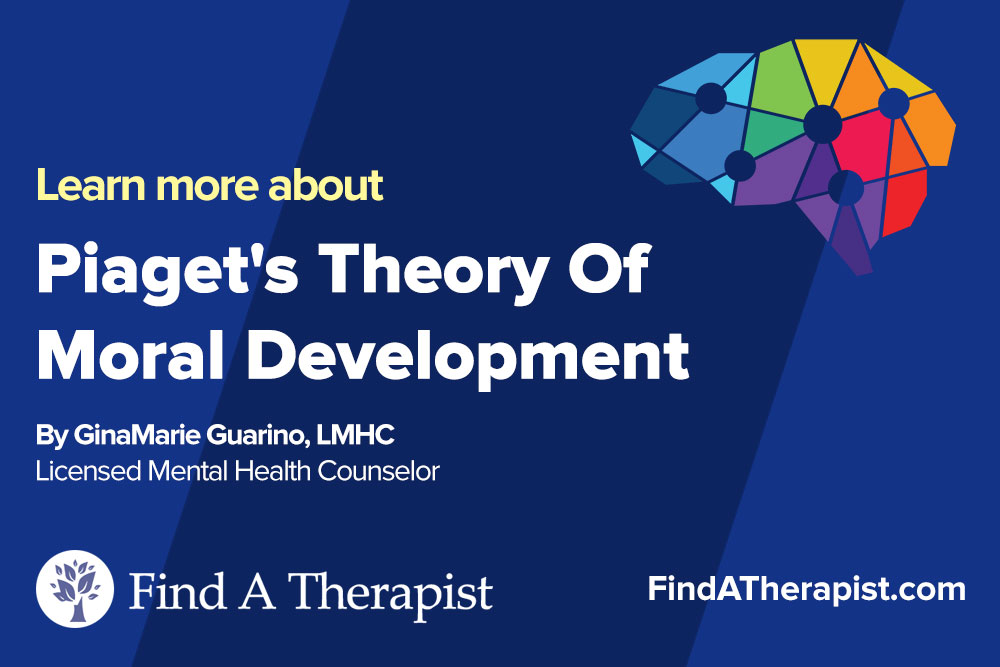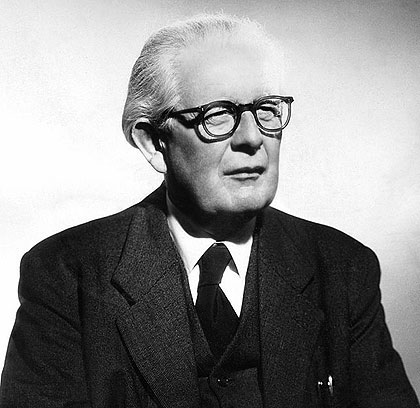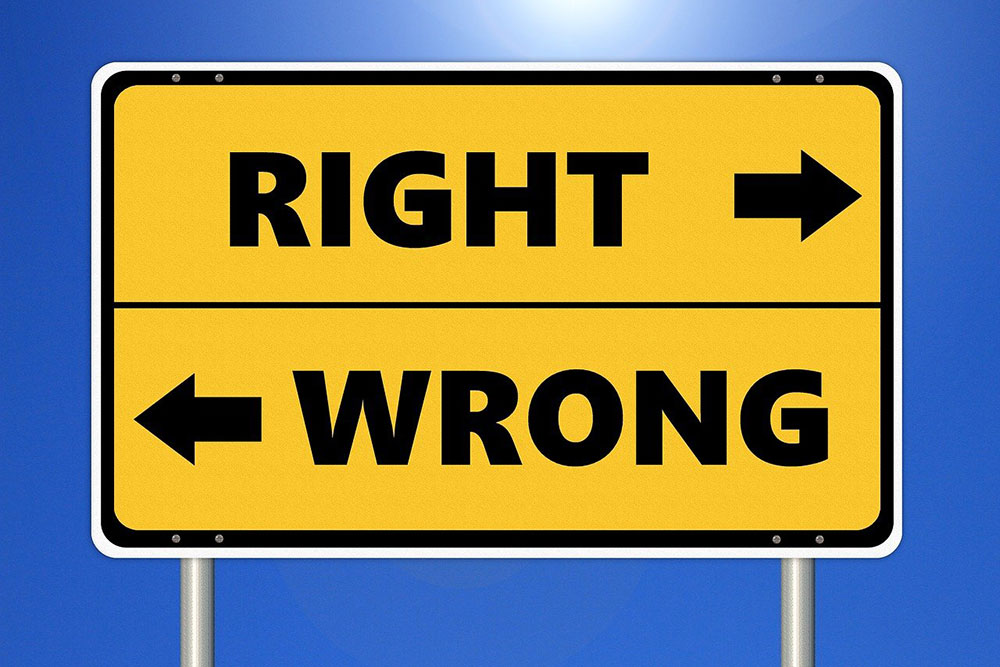Piaget’s Theory Of Moral Development
Published on April 27th, 2020
Updated on January 2nd, 2024

Contents
Jean Piaget was a psychologist who focused on child development. He has published a series of articles and journals about how children develop in the 1920’s and 1930’s. He is well-known theory for his theory of cognitive development. In this theory, Piaget breaks down child cognitive development into stages. These stages are reflected in his theory of moral development in children.
In his works, Piaget makes the connection between cognitive development and moral development. He believed that each form of development affects each other. According to Piaget, as a child’s thinking develops, so does their moral code. As thinking becomes more dynamic and logical, morality also becomes more dynamic and logical.
Sponsored by

Choose a therapist to work with and start healing with 20% off from BetterHelp.
Click Here
Piaget also believed that morality becomes more abstract as a child grows older. In his studies, he notes a shift from moral decisions being based on rules to moral decisions being based on relationships with others. Interpretation of rules becomes more complex, and external factors are considered in moral development while also considering conditions of the rules.
Evidence from Piaget’s theories and studies supports that development progresses as a child ages. The child’s understanding of morality is based on life factors. These life factors change as the child’s ability to think and use reason matures. Considering this, Piaget believed that morality develops based on the following components:
- the child’s age
- the child’s cognitive development
- the child’s developmental stage
Piaget believed that child development is based on challenges. Children develop as they continue to overcome different challenges that they face. These challenges are based on the child’s age and stage of life. Piaget believed that challenging what a child ‘knows’ about the world results in personal growth. Overcoming challenges causes children to develop new beliefs. This concept of challenge and growth applies to both their cognitive growth and their moral development.
The challenges that children face help them build a stronger and more dynamic understanding of how the world works. This ability to challenge what they ‘knew’ helps children to grow. It aids in the development of decision making skills. It also matures the process of understanding and making decisions based off of morality.
Morality During Childhood
The understanding of morals begins to develop in a child around age 5. Before age 5, a child’s concept of moral thinking is based on actions and consequences. During this time, a child makes their decisions based on what they expect will cause negative consequences.
By age 5, a child’s moral understanding has grown past considering what is and is not followed by negative consequences. At this age, the child’s understanding of what is right and wrong has been established. This understanding weighs heavily on the rules that have been established at home and at school. A way a child understands moral behavior is black and white, and rules are ultimate.
Between 5 and 10 years old, a child learns about morality from the influence that comes from figures of authority. The most common figures of authority that model moral behavior include:
- Parents
- Teachers
- Caretakers
- Grandparents
According to children in this age group (5-10 years old), the rules that these authority figures teach are absolute. Authority figures and the rules they create cannot be questioned or challenged.
Children take the lessons of morality that they learn from authority figures and understand them as absolute truth. Their word is what will be acceptable, and challenging the lessons and rules of morality is wrong. In the eyes of a child, defying the rules and codes of morality imparted from authority figures is in itself, immoral.

Morality of Constraint
The term ‘Morality of Constraint’ is used in Piaget’s theory. It refers to a child’s rigid beliefs of morals in terms of action and consequence. Morality of Constraint refers to a child’s inability to see rules as negotiable or flexible. In this stage, rules are very black and white. They are fixed and unwavering.
Example: A child would see the act of dropping a glass of milk as wrong. Since the act is wrong, it is punishable. This is because a child is not supposed to make a mess with food or drinks in the kitchen. They are also not supposed to break things.
If a child does break a glass, they will believe “since I dropped the glass of milk made a mess, I acted badly (or immorally)”. The child does not consider the concept of an accident when determining whether what they did was moral or immoral.
Relative Morality
As a child grows and develops, they begin to understand the perspective of different people. Through developing this understanding, children begin to challenge the rules. This marks the beginning of relative morality. This relative morality continues to mature during adolescence.
As a child approaches adolescence, their understanding of morality becomes less about right and wrong. It becomes more dynamic, as principles beyond the rules are considered.
Children may begin to challenge the rules, and the rationale for the rules. This is especially the case if they see the rules as unfair or unjust. They may also begin to negotiate punishments and the rules themselves.
Morality of Cooperation
A child’s perspective of morality begins to change around age 9. Instead of seeing Morality of Constraint, they begin to see ‘Morality of Cooperation’. Morality of Cooperation develops around the same time as the child develops autonomy from their parents. The child begins to learn how to relate to others. In learning how to relate to others, they also learn how to cooperate with others. The need for cooperation fuels the changing view of morality. There is a shift of morality coming from authority, to morality coming from social cooperation.
In the Morality of Cooperation stage, the child develops a better understanding of different points of view. As a result, they begin to realize that rules are not so black and white.
As a child progresses into the stage of Morality of Cooperation, they see moral decisions to be based on the terms of consent. Rules and expectations become more flexible. Compromise and negotiation are both viable options when it comes to rule making.
With age, the child begins to determine their own standards of morality. These standards of morality are based on their own life experiences. The child is not as egocentric as before. They learn how to consider the perspectives of other people. The child will consider these perspectives before determining the standard for behavior in a given situation.
With this understanding of rules that develop with cooperation comes a new moral expectation. The new moral expectation is for the punishment fitting the crime. At this point, rules are still valued, but if the child believes that the punishment for breaking the rules is unfair or unjust, they may protest. They may also begin to use negotiation skills. If they feel a punishment is unjust, they may negotiate in order to determine a suitable punishment for their transgressions.
Morality During Adolescence
During adolescence, a child begins to realize that different people have different standards of moral behavior. They understand that different people have different perspectives on morality. These different perspectives are based on each individual’s own experiences. An adolescent also understands that as a result of people having different perspectives, each individual person may approach a moral dilemma in a different way.
Adolescents also begin to understand that morals depend on more than one factor. Morality is no longer based only on the rules of authority figures or social standards. Adolescents begin to recognize that extenuating circumstances may change the path of a moral compass. They also understand that details of a situation matter, and should be taken into consideration when determining how to act or react to a situation.
Factors that begin to be considered when determining moral decisions in adolescence include:
- Motivation for a person’s behavior
- Events leading up to the moral dilemma
- Perspectives of other people
- Intention of a person’s actions or reactions
- Understanding of a situation and the influencing factors
- Understanding of the rules of a setting or environment
This differs from earlier ages. In earlier stages, morals were only determined based on the context of the rule. Adolescents learn that you can dispute or challenge rules. They learn that not all figures of authority are just or moral. They also learn that challenging unjust rules can lead to change. As a result, they develop the understanding that standing up for one’s own moral compass is supported and encouraged by peers.
Example: An adolescent may understand that making fun of a peer is wrong, regardless of whether or not the peer is present to hear the insults. They may feel uncomfortable and unhappy when hearing their friends make fun of a classmate.
This discomfort is due to the belief that just because their classmate does not know what they are saying about them, does not mean it is okay to say mean things. As a result, the adolescent may speak up to their friends. They may try to convince or explain that it is not okay to make fun of their classmate, even though they are not around.
Reciprocity of Moral Decisions
A major lesson learned in adolescence is that there is something to gain from being moral. Moral decisions can be beneficial to everyone, including oneself. With this discovery, the appreciation of morality strengthens. Adolescents develop a deeper understanding for the purpose of rules and social construct, though they may not always respect the rules themselves.
The concept of ‘fair’ and ‘just’ do not only apply to right and wrong. They also apply to the preservation of benefit and wellbeing of all parties. In this discovery, an adolescent is more inclined to behave based on a moral code. If they behave against the moral code, they do so with the understanding that their actions have consequences that affect more than just themselves.
Simple Reciprocity vs. Ideal Reciprocity
The concept of making moral decisions for one’s own personal interest develops in stages. To begin, the adolescent understands morality in a simple fashion. They view it as an even exchange of manners and politeness. The adolescent understands moral reciprocity in the concept of ‘if you wash my back I will wash yours’. This is the concept of ‘simple reciprocity’. Simply reciprocity suggests that there will be an even exchange of gestures between people. This means that one moral favor will be exchanged for another moral favor.
Example: Sandra, who is 13 years old, wants to go to the movies after dinner tonight, but it is her day to do the dishes. Sandra knows it is her turn to do the dishes because Billy, her brother, did them yesterday.
Sandra decides to ask Billy to do the dishes tonight, and offers in exchange that she does the dishes for the next two nights. This way, Billy does not have to take on more of the household responsibilities than she does. Sandra considers this an offer of even exchange, where the split of responsibilities is fair.
Billy, who is 17 years old, knows that Sandra has been wanting to see this movie for a long time. She is also looking forward to seeing her friends and sharing the experience with them. Billy understands that seeing this moving is important to Sandra. He also considers that he does not have anything to do tonight besides some homework.
Billy knows that if he covers for Sandra, she will be able to enjoy herself with her friends. He wants his sister to enjoy herself, and knows that she would want the same for him. If the roles were reversed, Billy knows that Sandra would cover for him, so he agrees to do the dishes tonight.
Billy is illustrating the concept of ideal reciprocity. Ideal reciprocity refers to the intention to treat others fairly. People who act through ideal reciprocity consider factors related to their relationship to others. It reflects the process of ‘treat others the way you would want to be treated’.
When a person is acting through ideal reciprocity, they are acting based on their relationship with the person in question. They are considering how they would expect to be treated if the roles were reversed. A person acting through ideal reciprocity considers what the respectful form of behavior is, rather than what they get in return.
In this behavior, an adolescent illustrates the understanding that morality is based on different interpretations and conditions to the rules. It is based more on the relationship with other people, and less on an equal negotiation and exchange to the rules.
Sponsored by

Find an affordable therapist online with 20% off from BetterHelp.
Click Here






Leave A Reply